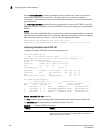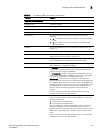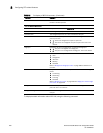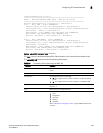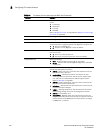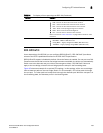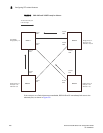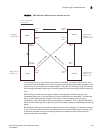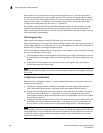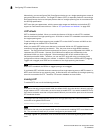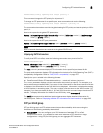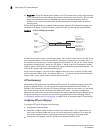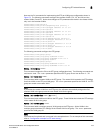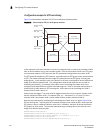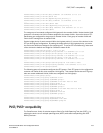
268 PowerConnect B-Series FCX Configuration Guide
53-1002266-01
Configuring STP related features
8
Once a failover occurs, the Switch no longer has an alternate root port. If the port that was an
alternate port but became the root port fails, standard STP is used to reconverge with the network.
You can minimize the reconvergence delay in this case by setting the forwarding delay on the root
bridge to a lower value. For example, if the forwarding delay is set to 15 seconds (the default),
change the forwarding delay to a value from 3 – 10 seconds.
During failover, 802.1W Draft 3 flushes the MAC addresses leaned on the unavailable root port,
selects the alternate port as the new root port, and places that port in the forwarding state. If
traffic is flowing in both directions on the new root port, addresses are flushed (moved) in the rest
of the spanning tree automatically.
Reconvergence time
Spanning tree reconvergence using 802.1W Draft 3 can occur within one second.
After the spanning tree reconverges following the topology change, traffic also must reconverge on
all the bridges attached to the spanning tree. This is true regardless of whether 802.1W Draft 3 or
standard STP is used to reconverge the spanning tree.
Traffic reconvergence happens after the spanning tree reconvergence, and is achieved by flushing
the Layer 2 information on the bridges:
• Following 802.1W Draft 3 reconvergence of the spanning tree, traffic reconvergence occurs in
the time it takes for the bridge to detect the link changes plus the STP maximum age set on the
bridge.
• If standard STP reconvergence occurs instead, traffic reconvergence takes two times the
forward delay plus the maximum age.
NOTE
802.1W Draft 3 does not apply when a failed root port comes back up. When this happens, standard
STP is used.
Configuration considerations
802.1W Draft 3 is disabled by default. To ensure optimal performance of the feature before you
enable it,do the following:
• Configure the bridge priorities so that the root bridge is one that supports 802.1W Draft 3.
(Use a Dell PowerConnect device or third-party device that supports 802.1W Draft 3.)
• Change the forwarding delay on the root bridge to a value lower than the default 15 seconds.
Dell recommends a value from 3 – 10 seconds. The lower forwarding delay helps reduce
reconvergence delays in cases where 802.1W Draft 3 is not applicable, such as when a failed
root port comes back up.
• Configure the bridge priorities and root port costs so that each device has an active path to the
root bridge if its root port becomes unavailable. For example, port 3/4 is connected to port
2/4 on Switch 2, which has the second most favorable bridge priority in the spanning tree.
NOTE
If reconvergence involves changing the state of a root port on a bridge that supports 802.1D STP but
not 802.1W Draft 3, then reconvergence still requires the amount of time it takes for the ports on
the 802.1D bridge to change state to forwarding (as needed), and receive BPDUs from the root
bridge for the new topology.



